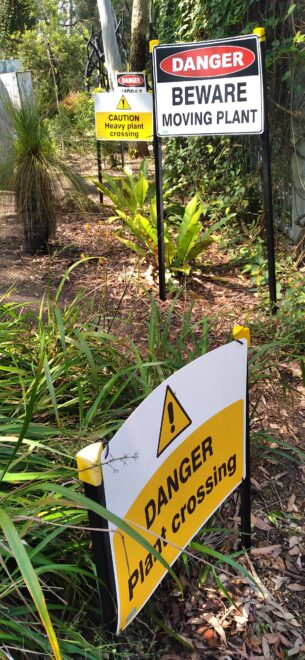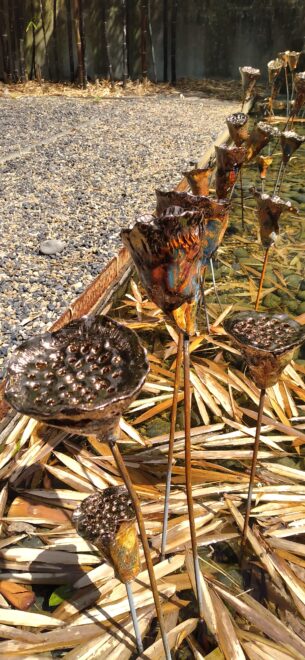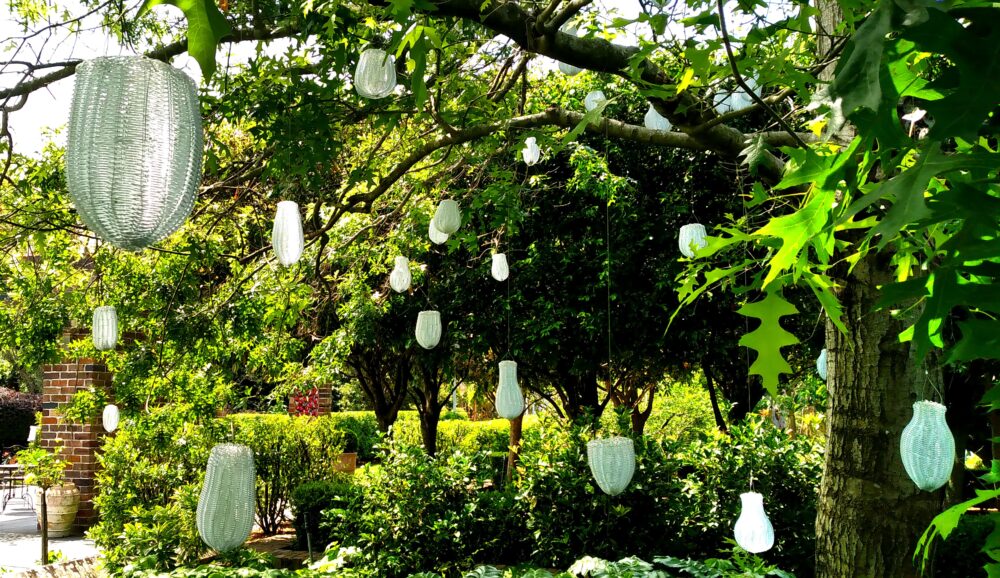Stuart Read reviews the Eden Unearthed: sculpture exhibition, Eden Gardens & Garden Centre, 307 Lane Cove Road (cnr. M2/Fontenoy Road), Macquarie Park, Sydney, until April 2024. The curator is Meredith Kirton, a horticultural journalist and curator, and AGHS member.
Image above: ‘Whispering Canopy’ by Gillian Minka. Woven lanterns dangle from the limbs of a pin oak
More information, the catalogue, interviews, workshops (timed for school holidays) are at: https://edengardens.com.au/pages/eden-unearthed and photos at @edenunearthed2023.
This is only my second visit, but it’s the seventh such outdoor exhibition. The sculptures are place across 2.5 acres in a diverse, interesting range of display gardens, which are parts of the expansive garden centre and associated buildings (including café and restaurant). And, thanks to the website and Instagram, virtual visits are quite the thing.
Works of 34 Australian artists of all ages, from young to ‘mature’ (a first, and fascinating) are on temporary display for six months. These add to the permanent sculptures here, which number thirteen. The sculptures respond to the site and settings, some intimately, some more abstractly. Clever ‘riffing’ off nature, borrowed views, light and sound effects are part and parcel of some works. Elsewhere, interactivity, inviting viewers to be and take part in making, the art work, evolve, are the thing,. As is using recycled materials in creative ways (including plastic ‘mesh’ and bags, as substrate to grow shiitake mushrooms, in the case of ‘Entanglement: from Trash to Treasure’ by Entangled (Dinah Taprell, Jane Lush & Belinda Piggott). You’ll never look at that small bag of garlic the same, again.

Environments, risks, threats to them and joys and delights in them are a constant theme. As are challenges and changes, such as climate change, erosion or human interference. ‘Moving Plant’ by Francois Limondin, is a clever play on the word ‘plant’ and its varied meanings on warning signs and fluoro that have nothing to do with the natural world: gentle humour at work here
‘The Forest Guardian’, a ‘green man’ in relief from sandstone blocks on a wall, by landscaper and stonemason, Stuart Weir, greets you on your way in. A tremendous labour of love, rich in symbolism and links – to nature, forests, myths.
This is Australia’s largest privately funded exhibition of its kind. Sponsors help artists get a public ‘airing’ and exposure to people perhaps less inclined to the gallery scene. Workshops and school interactions help widen its focus to groups in the community – a clever idea and clearly popular.
Works catching this reviewer’s roving eyes include gently humorous swing ‘Come Together’ by Sarah Yaacoub, comprising two loaves of flatbread and rope – dangling temptingly from a Chinese elm. Apparently, the local possums think this is the winning work, so luckily the artist can whip up another loaf or two to keep them and the viewing public happy, going forward.
‘Going, Going, Gone’ is a small work in copper wire, making banksia bushes, glinting, and catching the light. It speaks to the disappearing Eastern Suburbs Banksia Scrub, an endangered ecological community in Sydney’s east, with the high number of lemming-humans building ever fatter houses in which to gaze at the ocean but clearing every native plant in doing so. These glinting copper hues, against the lime green of freshly shed bark on lemon scented gum trees, was a treat.
‘Laughing Kookaburras’ by deliciously named Diamando Koutsellis is a series of scatters, clusters, and the odd individual ceramic kookaburra(s), perched on fences, rocks, structures: whimsy and delight.
Also quietly appealing and clever is ‘Breathe’ by Georgina Galea, painted ‘totem poles’ with patterns of plant stomata on them – these are the holes in leaves that allow for gas exchange: breathing, if you like – oxygen in, carbon dioxide and water vapour, out. Quiet education.
‘Future remnant’ by Pamela Lee Brenner and Johannes Muljana are twirling mobiles from an overhead walkway structure, catching every breeze. As does ‘Suspension’ by Allyson Adeney, which first strikes you as strings of deep purple ‘prayer flags’ or pennants and interacts with nearby ‘Impressions Exhibition’ by Christina Frank, which comprises hanging banners of translucent fabric, impressed with bark bumps and markings from the eucalypt trees in the adjoining Lane Cove National Park. Delicate, mobile, clever and beautiful. Those dark violet flag tones are also slightly sinister, all catching every wisp of wind – sculpture that jiggles, dances.
Smaller works are tucked in woodland and denser parts of the gardens. ‘Lenticular Mirror’ by Leyla Oz is a triangular structure covered in long thin mirrors – disconcerting images of the viewer, shift as you do, warping and refracting to show the surrounding trees and setting. Mesmerising. ‘Tawny Frogmouth’ by Renate Crow is a tribute to a beloved, if ‘ugly’, native bird – made of cane and fibres, it was the gardeners’ favourite, and easy to see why. ‘Molly’s Garden’ by Madeleine Hayes & Aaron Blakey is a diminutive garden party setting, on rock near an artificial creek – enchanting fairy scene.

A circular labyrinth of bamboo and other things is ‘Seeding Kairos Time’ by Leanne Thompson: a bold work that will evolve with additions over the six months. Striking at ground level and from above. ‘The chant of silence’ by Jayanto Tan is a hanging mobile of large circular discs, which on closer inspection are made of dried used tea bags – paying homage to Indonesian family rituals of tea drinking, domestic cooking, and family reverberations on identity. Thoughtful, cathartic beauty.
One that appeals to me a good deal is ‘Whispering Canopy’ by Gillian Minka. Woven lanterns or basket lights dangling from the limbs of a pin oak tree, it cleverly catches light, in its translucent blue-green materials, and draws attention to the beauty of the canopy of this tree. That she has family links to weaving, baskets and such only enriches your enjoyment of these bobbing forms.
If I were to deem a winner it might be ‘Golden Era’ by Julie Milton – ceramic ‘lotus seed pods’ arranged in a long, rectangular, Islamic-looking tank pond, with bamboo frame and shed bamboo leaves around as well as gurgling water. The pods are metallic in colouration and sheen – hard to do, I gather, in ceramics. They’re also botanically accurate – the source of ‘the Lotus eaters’. Gorgeous, and, I note, used as the cover image on the exhibition brochure.
The sustainability award winner is ‘Love Song’ by Murray and Burgess – charred black boughs from the 2020 bush fires through the Blue Mountains, with bright golden flecks, paeans to the Regent honeyeater birds whose plumage is black and white, with flashes of yellow. Now endangered due to a lack of males. A breeding program is underway seeking to address this risk. Clever, poignant work.
Overall site design was by Jon Shinkfield (of Pittendrigh, Shinkfield, Bruce: PSB), including the ‘sunken Coriolis spiral’ reservoir. Garden rooms and areas of distinct, varying character allow for variety and mean there will be parts appealing to everyone: from hot sun and openness to dense shade and privacy.
There is much more, and what appeals to you won’t to me – so have a look online or visit a few times. People’s likes are always amusingly divergent from judges’ – and rightly so. A monthly draw from your choices offers a prizes of lunch for two. There will be a final People’s Choice winner on 1 May 2024.
Some works are for sale, so you might want to enquire. Workshops offer chances to meet, interact and work with artists, as well as test and stretch your creative juices. Perhaps you’ll be inspired to make a sculpture for your garden, your local park or community garden.
[Photos by Stuart Read]


